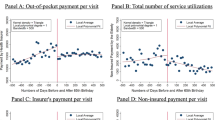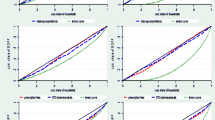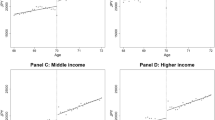Abstract
Establishing how to reform the cost-sharing policy to reduce waste in health-care utilisation is an important issue, especially in an ageing society. Using a generalised method of moments (GMM) for the dynamic panel count model during the period 1997–2007 from the National Health Insurance (NHI) programme in Taiwan, this study examines the effects of persistent behaviour and the cost-sharing policy on outpatient medical utilisation for Taiwan’s elderly. Empirically, we find positive and negative coefficient estimations for persistent behaviour and price elasticity, respectively, thereby creating a clear trade-off effect of the cost-sharing policy on health-care utilisation. Furthermore, our study finds that the short-run price elasticity (−0.2561) is always smaller than long-run elasticity (−0.4052). Finally, the empirical results indicate that the price elasticity for females and patients with high medical expenditure, low income, high chronic diseases and good health is higher than that for males and patients with low medical expenditure, high income, low chronic diseases and bad health.
Similar content being viewed by others
Notes
Nilsen et al. (2012).
Cunningham (2009).
Hirth et al. (2015).
Kohn and Liu (2013).
Ministry of Health and Welfare (2014).
Robyn et al. (2012).
Gardner et al. (2011).
Ngo (2014).
Manning et al. (1987).
Trottmann et al. (2012).
Curtis and MacMinn (2008).
National Health Insurance 2012–2013 Annual Report, edited by the Bureau of National Health Insurance.
Tian et al. (2012).
According to the report by the NHIRD, no significant difference was found in the distribution (χ 2 = 1.74, df = 1, p-value = 0.187) between the patients in our study and the original NHIRD (http://nhird.nhri.org.tw/en/index.htm).
Those NHI-defined chronic diseases include cancer (12), dysthyreosis (05), diabetes (01), Hyperlipidemia (19), Wilson’s Disease (48), gout (07) and disorders related to endocrine and metabolic systems (52, 70, 71, 80, 93). Detailed chronic diseases defined by the NHI can be found at the following website: http://www.nhi.gov.tw/webdata/webdata.aspx?menu=18&menu_id=703&webdata_id=1022.
The NHI data set records the patients’ monthly salary level to charge their monthly premiums.
(see Arellano and Bond (1991), for details).
Holtz-Eakin et al. (1988).
Windmeijer and Sliva (1997).
The days stayed in hospital each year is obtained by aggregating the days that the patient stayed in hospital each year and used to proxy catastrophic health events (e.g. cancer, heart attack), which may be related to regular follow-ups, resulting in higher medical utilisation following the care received for the illness (Kohn and Liu).
Musolesi and Nosvelli (2007).
The average outpatient utilisation for elderly Taiwanese is also greater than that for elderly Koreans (approximately 24.46 times) (Kim et al. (2005).
Some other count data models such as zero-inflated Poisson, binomial, and generic mixture models have been proposed to deal with dependent variables possessing an ‘excess’ of zeros relative to standard distributions.
The exchange rate of the Taiwanese dollar to the U.S. dollar is 30:1.
The average effective price is much smaller than that for elderly Koreans, which has a coinsurance rate of 54 per cent (Kim et al. (2005).
We also calculated the summary statistics of inpatient utilisations for the elderly. The average days spent in hospital by the elderly is 2.55 days, and the standard deviation of inpatient utilisation for the elderly is 10.79 days.
Liu and Wen (2010).
Musolesi and Nosvelli (2007) estimated the residential water demand function of Italian municipalities to calculate short-run and long-run price elasticities. Using a dynamic framework for a panel of Italian municipalities, the system GMM estimator shows that persistence of habits is coupled with high long-term price elasticity, which is higher than the one-year price elasticity.
Gaynor et al. (2007).
Yang et al. (2003).
In Taiwan’s NHI programme, even though patients have taken a chronic prescription, they are still asked to visit a doctor within 90 days (the longest period), thus allowing health-care providers to check the fee schedule and drug formulary and enabling doctors to discuss previous medical records with patients and make a proper decision based on the assessment of the patients’ health statuses.
Getzen (2000).
Sargan (1958).
NHI-defined catastrophic illnesses include malignant neoplasm of thyroid gland, Hereditary factor VIII and deficiency. A detailed list of catastrophic illnesses is available at the NHI’s official website.
Wu (2003).
Wu (2001).
Duarte (2012).
Our empirical results are almost completely different from Duarte (2012) findings, that is, high-income individuals are more price sensitive than low-income individuals in the Chilean private health insurance market.
References
Arellano, M. and Bond, S. (1991) ‘Some tests of specification for panel data: Monte Carlo evidence and an application to employment equations’, Review of Economic Studies 58(2): 277–297.
Arellano, M. and Bover, O. (1995) ‘Another look at the instrumental variable estimation of error-components models’, Journal of Econometrics 68(1): 29–51.
Asiskovitch, S. (2010) ‘Gender and health outcomes: The impact of healthcare systems and their financing on life expectancies of women and men’, Social Science & Medicine 70(6): 886–895.
Ataguba, J. and McIntyre, D. (2009) ‘Financing and benefit incidence in the South African health system: preliminary results’, HEU Working Paper No, 09-1, Cape Town: Health Economics Unit.
Baicker, K. and Goldman, D. (2011) ‘Patient cost-sharing and healthcare spending growth’, The Journal of Economic Perspectives 25(2): 47–68.
Beck, R.G. (1974) ‘The effects of co-payment on the poor’, The Journal of Human Resources 9(1): 129–142.
Biró, A. (2013) ‘Copayments, gatekeeping, and the utilization of outpatient public and private care at age 50 and above in Europe’, Health Policy 111(1): 24–33.
Blundell, R. and Bond, S. (2000) ‘GMM estimation with persistent panel data: an application to production functions’, Econometric Reviews 19(3): 321–340.
Blundell, R., Griffith, R. and Windmeijer, F. (2002) ‘Individual effects and dynamics in count data models’, Journal of Econometrics 108(1): 113–131.
Blanciforti, L. and Green, R. (1983) ‘An almost ideal demand system incorporating habits: An analysis of expenditures on food and aggregate commodity groups’, The Review of Economics and Statistics 65(3): 511–515.
Carrieri, V. (2010) ‘The effects of cost-sharing in health care: What do we know from empirical evidence?’ Economia Politica 27(2): 351–374.
Chandra, A., Gruber, J. and McKnight, R. (2010a) ‘Patient cost-sharing and hospitalization offsets in the elderly’, American Economic Review 100(1): 193–213.
Chandra, A., Gruber, J. and McKnight, R. (2010b) ‘Patient Cost-Sharing in low income populations’, American Economic Review 100(2): 303–308.
Chandra, A., Gruber, J. and McKnight, R. (2014) ‘The impact of patient cost-sharing on low-income populations: Evidence from Massachusetts’, Journal of Health Economics 33: 57–66.
Chen, L., Yip, W., Chang, M.-C., Lin, H.-S., Lee, S.-D., Chiu, Y.-L. and Lin, Y.-H. (2007) ‘The effect of Taiwan’s National Health Insurance on access and health status of the elderly’, Health Economics 16(3): 223–242.
Cherkin, D.C., Grothaus, L. and Wagner, E.H. (1989) ‘The effect of office visit copayments on utilization in a health maintenance organization’, Medical Care 27(11):1036–1045.
Chernew, M.E. and Newhouse, J.P. (2008) ‘What does the RAND health insurance experiment tell us about the impact of patient Cost-Sharing on health outcomes?’, American Journal of Managed Care 14(7): 412–414.
Chiappori, P.-A., Durand, F. and Geoffard, P.-Y. (1998) ‘Moral hazard and the demand for physician services: First lessons from a French natural experiment’, European Economic Review 42(3–5): 499–511.
Cohen, S.B., Ezzati-Rice, T. and Yu, W. (2006) ‘The utility of extended longitudinal profiles in predicting future health care expenditures’, Medical Care 44(5): I45–I53
Cohen, S.B. and Yu, W. (2012) The concentration and persistence in the level of health expenditures over time: Estimates for the U.S. population, 2009–2010 Statistical Brief No. 392, Rockville, MD: Agency for Healthcare Research and Quality, from http://meps.ahrq.gov/mepsweb/data_files/publications/st392/stat392.pdf.
Contoyannis, P., Jones, A.M. and Rice, N. (2004) ‘The dynamics of health in the British Household Panel Survey’, Journal of Applied Econometrics 19(4): 473–503.
Cunningham, P.J. (2009) Chronic Burdens: The Persistently High Out-of-Pocket Health Care Expenses Faced by Many Americans with Chronic Conditions, Issue Brief, publication 1303, The Commonwealth Fund.
Curtis, L.J. and MacMinn, W.J. (2008) ‘Health care utilization in Canada: twenty-five years of evidence’, Canadian Public Policy 34(1): 65–87.
De Jong-Gierveld, J. and van Solinge, H. (1995) Ageing and Its Consequences for the Sociomedical System, Population Studies No. 29, Strasbourg: Council of Europe Press.
Duarte, F. (2012) ‘Price elasticity of expenditure across health care services’, Journal of Health Economics 31(6): 824–841.
Eichner, M.J. (1998) ‘The demand for medical care: What people pay does matter’, The American Economic Review 88(2):117–121.
Feldman, R., Dowd, B., Leitz, S. and Blewett, L.A. (1997) ‘The effect of premiums on a small firm’s decision to offer health insurance’, The Journal of Human Resources 32(4): 635–658.
Feldstein, M.S. (1973) ‘The welfare loss of excessive health insurance’, Journal of Political Economy 81(2): 251–280.
Fuchs, V.R. and Kramer, M.J. (1972) Determinants of Expenditures for Physicians’ Services in the United States 1948–68, Rockville, MD: National Center for Health Services Research and Development.
Garber, A.M., MaCurdy, T.E. and McClellan, M.B. (1998) ‘Persistence of Medicare expenditures among elderly Medicare beneficiaries’, in A.M. Garber (ed.) Frontiers in Health Policy Research, Cambridge, MA: MIT Press, pp. 154–178.
Gaynor, M., Li, J. and Vogt, W.B. (2007) ‘Substitution, spending offsets, and prescription drug benefit design’, Forum for Health Economics and Policy 10(2): 1–31.
Gardner, B., de Bruijn, G.-J. and Lally, P. (2011) ‘A systematic review and meta-analysis of applications of the self-report habit index to nutrition and physical activity behaviours’, Annals of Behavioral Medicine 42(2): 174–187.
Gerdtham, U.-G. and Johannesson, M. (1999) ‘New estimates of the demand for health: results based on a categorical health measure and Swedish micro data’, Social Science & Medicine 49(10): 1325–1332.
Getzen, T. (2000) ‘Forecasting health expenditures: Short, medium and long (long) term’, Journal of Health Care Finance 26(3): 56–72.
Goldman, D.P., Leibowitz, A. and Robalino, D.A. (2004) ‘Employee responses to health insurance premium increases’, American Journal of Managed Care 10(1): 41–47.
Gruber, J. (2001) ‘The impact of the tax system on health insurance coverage’, International Journal of Health Care Finance and Economics 1(3–4): 293–304.
Gruber, J., and Lettau, M. (2004) ‘How elastic is the firm’s demand for health insurance?’, Journal of Public Economics 88(7–8): 1273–1293.
Gruber, J. and Washington, E. (2005) ‘Subsidies to Employee health insurance premiums and the health insurance market’, Journal of Health Economics 24(2): 253–276.
Gupta, S., Verhoeven, M. and Tiogson, E. (2001) Public Spending on Health Care and the Poor, IMF Working Paper WP/01/127, Washington, DC: International Monetary Fund.
Hirth, R.A., Gibson, T.B., Levy, H.G., Smith, J.A., Calónico, S. and Das, A. (2015) ‘New evidence on the persistence of health spending’, Medical Care Research and Review 72(3): 277–297.
Holliday, R. (1999) ‘Ageing in the 21st century’, The Lancet 354:siv4.
Holtz-Eakin, D., Newey, W. and Rosen, H.S. (1988) ‘Estimating vector autoregressions with panel data’, Econometrica 56(6): 1371–1395.
Kan, M. and Suzuki, W. (2010) ‘Effects of Cost-Sharing on the demand for physician services in Japan: Evidence from a natural experiment’, Japan and the World Economy 22 (1): 1–12.
Kapur, K., Rogowski, J.A., Freedman, V.A., Wickstrom, S.L., Adams, J.L. and Escarce, J.J. (2006) ‘Socioeconomic status and medical care expenditures in Medicare managed care’, Journal of Health Care for the Poor and Underserved 17(4): 876–898.
Kim, J., Ko, S. and Yang, B. (2005) ‘The effects of patient Cost-Sharing on ambulatory utilization in South Korea’, Health Policy 72(3): 293–300.
Kohn, J.L. and Liu, J.S. (2013) ‘The Dynamics of Medical Care Use in The British Household Panel Survey’, Health Economics 22(6): 687–710.
Kowalski, A.E. (2009) Censored Quantile Instrumental Variables Estimates of the Price Elasticity of Expenditure on Medical Care, NBER Working Paper No. 15085, Cambridge, MA: National Bureau of Economic Research.
Leibowitz, A., and Chernew, M. (1992) The Firm’s Demand for Health Insurance. Health Benefits and the Workplace, Washington, DC: U.S. Department of Labor, pp. 77– 84.
Liu, L.-F. and Wen, M.-J. (2010) ‘A longitudinal evaluation of residents’ health outcomes in nursing homes and residential care homes in Taiwan’, Quality of Life Research 19(7): 1007–1018.
Mangyo, E. (2004) Measuring the impact of health insurance on elderly physician visit: A natural experiment in Taiwan, working paper, University of Michigan.
Manning, W.G., Newhouse, J.P., Duan, N., Keeler, E.B., Leibowitz, A. and Marquis, M.S. (1987) ‘Health insurance and the demand for medical care: evidence from a randomized experiment’, The American Economic Review 77(3): 251–277.
Meng, Q., Jia, L. and Yuan, B. (2011) Cost-sharing mechanisms in health insurance schemes: A systematic review, working paper submitted to The Alliance for Health Policy and Systems Research, WHO.
Ministry of Health and Welfare. (2014) Taiwan Health and Welfare Report, Taipei City, Taiwan, available at http://www.mohw.gov.tw/MOHW_Upload/doc/2014_Taiwan_Health_and_Welfare_Report_0048686001.pdf.
Monheit, A.C. (2003) ‘Persistence in health expenditures in the short run: prevalence and consequences’, Medical Care 41(7): III53–III64.
Musolesi, A., Nosvelli, M. (2007) ‘Dynamics of residential water consumption in a panel of Italian municipalities’, Applied Economics Letters 14(6): 441–444.
Newhouse, J. (1993) Free for All: Lessons from the RAND Health Insurance Experiment, Cambridge, MA: Harvard University Press.
Ngo, P.V. (2014) ‘Habit formation in state-dependent pricing models: implications for the dynamics of output and prices’, Economics Letters 123(3): 336–340.
Nilsen, P., Roback, K., Broström, A. and Ellström, P.-E. (2012) ‘Creatures of habit: accounting for the role of habit in implementation research on clinical behaviour change’, Implementation Science 7(53): 1–6.
Phelps, C.E. and Newhouse, J.P. (1974) ‘Coinsurance, the price of time, and the demand for medical services’, The Review of Economics and Statistics 56(3): 334–342.
Polsky, D., Stein, R., Nicholson, S., Bundorf, M.K. (2005) ‘Employer Health Insurance Offerings and Employee Enrollment Decisions’, Health Services Research 40(5 pt 1):1259–1278.
Riley, G.F. (2007) ‘Long-term trends in the concentration of Medicare spending’, Health Affairs 26(3): 808–816.
Ringel, J.S., Hosek, S.D., Vollaard, B.A. and Mahnovski, S. (2002) The elasticity of demand for health care: A review of the literature and its application to the military health system, Santa Monica, CA: RAND Health.
Robyn, P.J., Fink, G., Sié, A., Sauerborn, R. (2012) ‘Health insurance and health-seeking behaviour: Evidence from a randomized community-based insurance rollout in rural Burkina Faso’, Social Science & Medicine 75(4): 595–603.
Rosen, B., Brammli-Greenberg, S., Gross, R. and Feldman, R. (2011) ‘When co-payments for physician visits can affect supply as well as demand: findings from a natural experiment in Israel’s national health insurance system’, International Journal of Health Planning and Management 26(2): e68–84.
Rosett, R.N. and Huang, L.-F. (1973) ‘The effect of health insurance on the demand for medical care’, Journal of Political Economy 81(2): 281–305.
Royalty, A.B. (2000) ‘Tax preferences for fringe benefits and workers’ eligibility for employer health insurance’, Journal of Public Economics 75(2): 209–227.
Sargan, J.D. (1958) ‘The estimation of economic relationships using instrumental variables’, Econometrica 26(3): 393–415.
Scitovsky, A.A., and Snyder, N.M. (1972) ‘Effect of coinsurance on use of physician services’, Social Security Bulletin 35(6): 3–19.
Scitovsky, A.A., and McCall, N. (1977) ‘Coinsurance and the demand for physician services: four years later’, Social Security Bulletin 40(5): 19–27.
Tamm, M., Tauchmann, H., Wasem, J. and Gress, S. (2007) ‘Elasticities of market shares and social health insurance choice in Germany: A dynamic panel data approach’, Health Economics 16 (3):243–56.
Tian, W.-H., Tien, J. J., Chen, C.-S. and Liu, T.-C. (2012) ‘Private health insurance and inpatient service utilization among adults and elderly people under Taiwan’s National Insurance Programme’, The Geneva Papers on Risk and Insurance—Issues and Practice 37(4): 655–677.
Trottmann, M., Zweifel, P. and Beck, K. (2012) ‘Supply-side and demand-side Cost-Sharing in deregulated social health insurance: Which is more effective?’, Journal of Health Economics 31(1): 231–242.
Wedig, G.J. (1988) ‘Health status and the demand for health: results on price elasticities’, Journal of Health Economics 7(2): 151–163.
Williams, K. and Umberson, D. (2004) ‘Marital status, marital transitions, and health: A gendered life course perspective’, Journal of Health and Social Behaviour 45(1): 81–98.
Windmeijer, F.A.G. and Santos Silva, J.M.C. (1997) ‘Endogeneity in count data models: an application to demand for health’, Journal of Applied Econometrics 12(3): 281–294.
Windmeijer, F. (2002) ‘ExpEnd, A Gauss programme for non-linear GMM estimation of exponential models with endogenous regressors for cross section and panel data’, Cemmap Working Paper CWP14/02, London: Centre for Microdata Methods and Practice.
Windmeijer, F. (2006) ‘GMM for panel count data models’, Cemmap working paper Working Paper CWP21/06, London: Centre for Microdata Methods and Practice.
Winkelmann, R. (2004) ‘Health care reform and the number of doctor visits—an econometric analysis’, Journal of Applied Econometrics 19(4): 455–472.
Wu, S. (2001) ‘Adapting to heart conditions: a test of the hedonic treadmill’, Journal of Health Economics 20(4): 495–508.
Wu, S. (2003) ‘Sickness and preventive medical behaviour’, Journal of Health Economics 22(4): 675–689.
Yang, N.-P., Chan, C.-L., Yu, I.-L., Lee, C.-Y. and Chou, P. (2010) ‘Estimated prevalence of orthopaedic fractures in Taiwan—A cross-sectional study based on nationwide insurance data’, Injury 41(12): 1266–1272.
Yang, N.-P., Chen, H.-C., Phan, D.-V., Yu, I.-L., Lee, Y.-H., Chan, C.-L., Chou, P. and Renn, J.-H. (2011) ‘Epidemiological survey of orthopedic joint dislocations based on nationwide insurance data in Taiwan, 2000–2005’, BMC Musculoskeletal Disorders 12(253): 1–7.
Yang, Z., Norton, E.C. and Stearns, S.C. (2003) ‘Longevity and health care expenditures: the real reasons older people spend more’, The Journal of Gerontology Series B: Psychological Sciences and Social Sciences 58B (1): S2–S10.
Author information
Authors and Affiliations
Corresponding author
Rights and permissions
About this article
Cite this article
Yang, C.J., Tsai, Y.C. & Tien, J.J. The Impacts of Persistent Behaviour and Cost-Sharing Policy on Demand for Outpatient Visits by the Elderly: Evidence from Taiwan’s National Health Insurance. Geneva Pap Risk Insur Issues Pract 42, 31–52 (2017). https://doi.org/10.1057/s41288-016-0022-3
Received:
Accepted:
Published:
Issue Date:
DOI: https://doi.org/10.1057/s41288-016-0022-3




